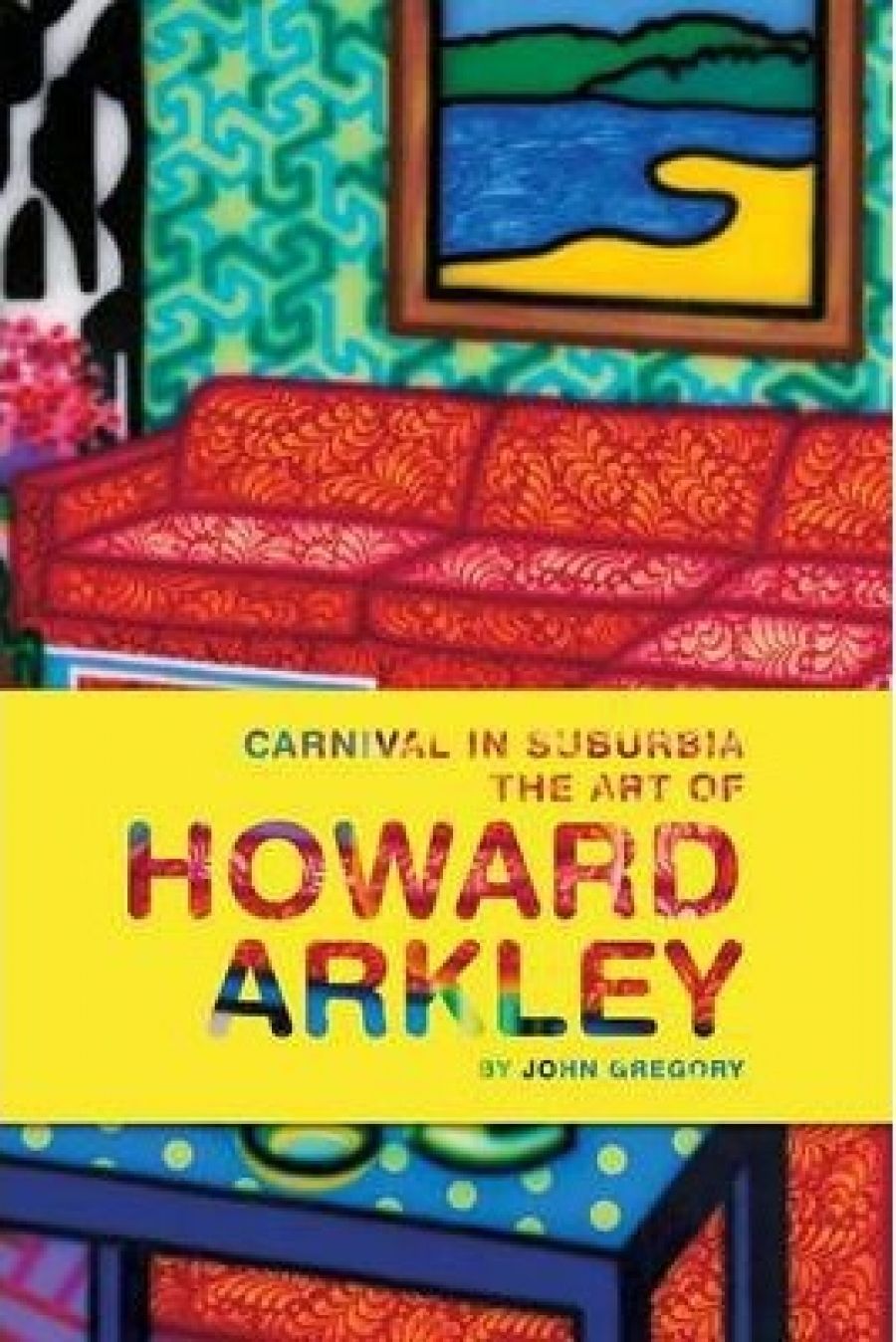
- Free Article: No
- Contents Category: Art
- Review Article: Yes
- Article Title: Suburban myths
- Online Only: No
- Custom Highlight Text:
The publication of a third major book on Howard Arkley begs the question: does he deserve such attention while other Australian artists of his generation and significance remain invisible on bookshop and library shelves? Has Arkley’s untimely and sensationalised death in 1999 been the main driver behind his broad appeal, or is he an artist who warrants further critical investigation? John Gregory’s impressive book, Carnival in Suburbia: The Art of Howard Arkley, proves unquestionably that the latter is the case, and tackles some of the myths that have been perpetuated, especially since the artist’s death.
- Book 1 Title: Carnival in Suburbua
- Book 1 Subtitle: The art of Howard Arkley
- Book 1 Biblio: CUP, $99.95 hb, 214 pp
- Book 1 Readings Link: booktopia.kh4ffx.net/NKvk4v
Gregory has chosen not to adopt the usual chronological approach, instead dividing the book into thematic chapters: suburbia, pattern and repetition, colour and line, sources, collaborations and, most interestingly, the final chapter, ‘Clowning, Transgression, Death and Rebirth’. The advantage of grouping an artist’s oeuvre thematically is that it provides ample scope for detailed analysis of ideas, subjects or techniques that recur and are developed (often subconsciously) over the course of a lifetime. A less interesting artist would rapidly dissolve under such close scrutiny. The greatest strength of Gregory’s analysis is the range and skilful deployment of both theoretical and art-historical references that provide a deeper understanding of Arkley’s work than has so far been offered. The author is an academic from Monash University who has taught a broad mix of courses in medieval, renaissance and baroque art and architecture, as well as film, fashion and advertising. Unsurprisingly then, he paints Arkley with a broad brush, drawing on references that range from Le Corbusier’s ‘crusade for Diogenes and whitewash’ to Mikhail Bakhtin’s notion of the ‘carnivalesque’. Gregory also draws on other fields of enquiry – such as music, psychoanalysis, cultural studies, French postmodern theory – to elucidate aspects of Arkley’s work, although he avoids getting bogged down in too much theoretical mud. Occasionally he misfires, as in his discussion of Arkley’s paintings as a kind of ‘dreaming’ for white Australia. While the idea itself may be worth exploring, it is his unquestioning citation of another author (Sean Kelly) that reveals an ignorance of the multiplicity and specificity of Aboriginal cultures.
From the start of the book, Gregory declares a personal interest in the project – he is the artist’s brother-in-law – and his insights are not only backed up by knowledge of the artist but also by posthumous access to his studio and to a friendship with the artist’s widow (to whom the book is dedicated). His interest in, and knowledge of, Arkley’s sources is extremely illuminating, and he quotes liberally from his notebooks and from published and unpublished interviews (unfortunately there is no list of primary sources in the bibliography). Gregory avoids hagiography by acknowledging limitations and weaknesses in some of Arkley’s work and by tackling the darker side of Arkley’s character, namely the impact of drugs on his work. He suggests, for example, that at later stages in his career Arkley may have been under some duress to produce works quickly and, as a consequence, occasionally executed paintings that were ‘uninspired and even mechanical duplicates’. The author is keen to identify and correct the errors of previous writers, and several of the footnotes make unusually interesting reading. He notes the lazy use of the terms ‘psychedelic’ or ‘Day-Glo’ to describe Arkley’s palette: ‘Rather than bringing to mind some whacked scene from Fear and Loathing in Las Vegas ... better parallels may be found in comic-book style, and related media also of interest to the artist, such as stained glass.’ More significantly, Gregory goes out of his way to dispel some of what he sees as the Arkley myths. Arguably the greatest of these is of the artist as a ‘champion of suburbia’. The author counters this simplistic view by asserting that, ‘depending on his state of mind, Arkley could see suburbia in either golden or melancholic light ... the contradiction itself should be seen as significant, unveiling a struggle in the artist’s own psyche’. At other times, Arkley’s suburban bungalows emit a ‘sense of malevolent spirit’. Gregory also points out that the ‘champion of suburbia’ lived for most of his adult life in inner-city Melbourne, only returning to his suburban roots some years before he died. In fact, while Gregory deals with the issue of suburbia in his first chapter, the rest of the book is devoted to less well-trodden ground, revealing Arkley to be a far more complex and considered artist than much of the hype has suggested to date.
The lavish design of Carnival in Suburbia marks a new departure in Australian art publishing for Cambridge University Press. The book’s weakest aspect is the overall quality of the colour reproductions, many of which fail to capture the crisp whites of Arkley’s early palette or the saturated luminosity of his late one. The design is striking but not overly fussy; most importantly, it enhances the experience of reading a book that is engaging and intelligent.


Comments powered by CComment